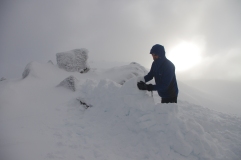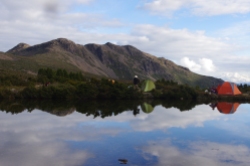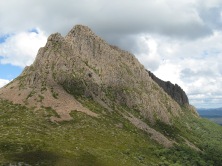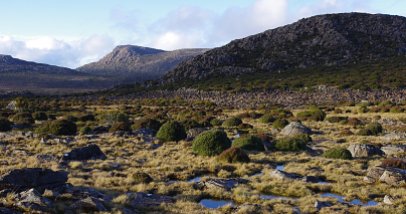The ‘luxury walk’ model is booming across Australia, leading to increased interest in the money-making potential of putting commercial developments in our national parks. New proposals are popping up across Australia, from Cooloola in Queensland’s Great Sandy National Park to the South Coast Track in Tasmania; from NT’s Kings Canyon to the Light to Light walk on the NSW south coast; Kangaroo Island in South Australia to the Falls to Hotham Alpine Crossing in Victoria’s Alpine National Park.
The proposal to build Snowy Hydro 2.0 to strengthen capacity for energy storage seemed like a good idea at first. But as the details of the project emerged, especially the likely direct physical footprint of the project, more and more people and groups started to oppose it. (Background stories on the issue are available here).
After the release of the Environmental Impact Statement (EIS) the NSW National Parks Association said that the plan ‘proposes a completely unacceptable level of damage to Kosciusko National Park’.
The project received approvals and is now being constructed. However documents tabled in the NSW Legislative Council reveal that the NSW Government will only receive $1.65 million from Snowy Hydro Ltd for the dumping of 14 million cubic metres of spoil in Kosciuszko National Park.
So, a large section of the Kosciuszko National Park (fifty-five hectares) will be impacted by the dumped waste, yet the NSW Government will receive barely 1/1000th of commercial waste disposal rates.
Continue reading “14 million cubic metres of spoil to be dumped in Kosciuszko National Park”
The most recent additions to the Tasmanian Wilderness World Heritage Area (TWWHA) in 2013 included thirty six thousand hectares of land previously allocated to forestry activities, a large number of small Regional Reserves and Conservation Areas, and some other tenures.
The state government is currently proposing that some (not all) of the forestry land be added to existing Regional Reserves and Conservation Areas. There is a chance for the community to provide input. The Tasmanian National Parks Association (TNPA) is calling on the state government to think big and establish the Kooparoona Niara (Great Western Tiers) National Park.
Continue reading “Kooparoona Niara (Great Western Tiers) National Park Proposed”
Our national parks rely on parks staff on so many levels, from managing tourism to fighting fires. Sadly, in Tasmania, austerity measures have been imposed on Department of Primary Industry, Parks, Water & the Environment (DPIPWE) employees, which includes park rangers and other Parks and Wildlife Service (PWS) staff.
Please add your voice and oppose the cut backs.
Continue reading “Speak up for the people who manage our parks”The Tasmanian Wilderness World Heritage Area (TWWHA) is a World Heritage Site in Tasmania. It is one of the largest conservation areas in Australia, covering 15,800 km², or almost 20% of lutruwita/ Tasmania. It is also one of the last great expanses of temperate wilderness in the world.
In recent summer’s, significant sections of the TWWHA have been devastated by bushfires. The 2018/19 fires were especially destructive.
Fire is perhaps the greatest challenge for the management of the TWWHA, particularly in the context of climate change. With the September 2020 release by the Parks and Wildlife Service of a range of discussion papers for public comment, the state is moving towards the development of a Fire Management Plan for the TWWHA, as recommended by the 2016 report by Tony Press (Tasmanian Wilderness World Heritage Area Bushfire and Climate Change Research Project) and prescribed by the 2016 TWWHA Management Plan.
How have the papers been received by conservationists?
Continue reading “A Fire Management Plan for the Tasmanian Wilderness World Heritage Area”The proposal to build Snowy Hydro 2.0 to strengthen capacity for energy storage seemed like a good idea at first. But as the details of the project emerged, especially the likely direct physical footprint of the project, more and more people and groups started to oppose it. (Background stories on the issue are available here).
After the release of the Environmental Impact Statement (EIS) the NSW National Parks Association said that the plan ‘proposes a completely unacceptable level of damage to Kosciusko National Park’.
However the federal government continues to pursue the proposal.
In response, it has been announced that the National Parks Association of NSW and ex-Energy Australia chair Ted Woodley are considering a legal challenge to the project, which they say will push back the transition to renewable energy and destroy thousands of hectares of national park.
We rely on healthy ecosystems for our survival. Victoria is the most cleared state in the country and natural ecosystems have faced centuries of land clearing, logging, invasion of invasive species and other threatening processes. The mountains that we love are already under threat from climate change: as fire seasons become longer and more intense, and as winter snowpack declines.
Now the Victorian parliament has announced an Inquiry into Ecosystem Decline. This is an important opportunity to show that the community wants to see ecosystems restored and species protected from extinction.
Please read on for ideas on how to write a submission to the Inquiry.
Continue reading “Parliamentary Inquiry into tackling the extinction crisis in Victoria”
The proposal for a commercial hut (a lodge) at Lake Rodway, below Cradle Mountain, has been on the cards for several years. It was one of the first proposals submitted to the Tasmanian government’s Expressions of Interest process to encourage commercial development in national parks and World Heritage Areas in 2015.
The proposal was originally called the ‘Cradle Base Camp Experience’. The proponent is the Tasmanian Walking Company (TWC), which currently operates the Cradle Huts, Bay of Fires and Three Capes (private huts) walks.
The proposal has now reached the detailed planning stage, with a Parks and Wildlife Service Reserve Activity Assessment (RAA) expected in the next few months. The TWC stated that this would be a Level 4 RAA (the highest level of scrutiny which includes public comment).
Continue reading “Lake Rodway commercial hut proposal reaches planning stage”
The Snowy Hydro 2.0 expansion started as a good idea. As the scale of the physical impact of the project became more obvious during the approvals process, environmental groups started to oppose it. After the release of the Environmental Impact Statement (EIS) the NSW National Parks Association said that the plan ‘proposes a completely unacceptable level of damage to Kosciusko National Park’.
It has now received planning approval from the NSW state government, despite ongoing objections over the project’s environmental impacts.
Continue reading “Approval of Snowy 2.0 EIS sets ‘appalling precedent’”
The community continues to oppose plans by the Tasmanian government to radically increase private commercial development in the state’s national parks and World Heritage Areas.
However, the government continues to push ahead with it’s anti environment agenda. Now it’s proposed Major Project Legislation is back for a third time and this version should ring alarm bells for everyone concerned about protecting wild places.
Main concerns about the legislation when it comes to wild places like World Heritage Areas include:
- The Major Projects Bill gives the minister total power to declare a major project which removes it from the normal local council planning process, and virtually any development that would normally go to a local council could be declared a major project.
- All controversial projects around Tasmania such as the cable car on kunanyi/ Mt Wellington or the Lake Malbena Helicopter proposal could be fast tracked.
- The community will have no right to appeal against the approval of a major project and will have limited right to have input.
Please make a submission – we have until May 15 2020.
Continue reading “No Fast Track for dodgy developers in Tasmania”
WED April 8: As part of the shutdown to help ‘flatten the curve’ and reduce the numbers of C-19 infections, a large number of areas in the High Country are being closed over Easter and beyond.
Government advice continues to be ‘If you can stay home, you must stay home’, meaning no travel for holidays, camping, etc.
VICTORIA
In Eastern Victoria
• Alpine National Park
• Baw Baw National Park
• Howqua Hills Historic Area
• Mount Buffalo National Park
Are all closed from midnight on April 8 ‘until further notice’. Further details here.
NSW
NPWS has closed all campgrounds, camping, on-park accommodation venues and visitor centres in Kosciuszko National Park until further notice.
This includes ‘wild and backcountry camping’ in all national parks.
In line with government restrictions on non-essential travel, the following iconic attractions in Kosciuszko National Park are closed for Easter:
- The summit of Mount Kosciuszko
- Thredbo Valley track
- Kosciuszko Lookout
- Cootapatamba Lookout
ACT
All visitor facilities within the ACT Parks and Conservation Service managed estate have been closed until further notice in response to a temporary shut-down of non-essential services across the ACT.
To stop the spread of COVID-19, the following facilities are closed to maintain social distancing measures:
- Tidbinbilla Visitor Information Centre
- Namadgi Visitor Information Centre
- Woods Reserve
- All ACT public campgrounds
- All playgrounds managed by ACT Parks and Conservation Service
Tidbinbilla Nature Reserve will also be closed, along with Namadgi National Park, which remains closed due to safety reasons following the Orroral Valley bushfire
All other parks and reserves across the ACT will remain open providing the community access to nature for recreation, health and wellbeing. Park visitors must observe social distancing whilst visiting parks and reserves. This means keeping 1.5 metres from others, avoiding large groups of people, avoiding peak usage periods and practicing good hygiene always.
TASMANIA
In an effort to prevent the spread of COVID-19 and keep our community safe, the Tasmanian Parks and Wildlife Service (PWS) has closed all national parks and reserves to public recreational use.
The closure of parks and reserves was in line with Tasmanian and Federal government measures to discourage the community from undertaking non-essential travel during this time. These closures include Wellington Park.
This includes:
- National Parks
- State Reserves
- Nature Reserves
- Game Reserves
- Conservation Areas
- Nature Recreation Areas
- Regional Reserves
- Historic sites.
All activities including day or overnight walks, mountain biking, hunting, other recreational activities and camping are now closed to the public until further notice.
The ongoing attempts by the Tasmanian government to encourage commercial developments in the state’s national parks and wilderness areas continues. While the high profile ‘helicopter tourism’ proposal planned for Lake Malbena on the Central Plateau has dominated the conversation in the last few months, a broader threat to the integrity of the reserve system is becoming apparent.
This relates to the draft Land Use Planning and Approvals Amendment (Major Projects) Bill 2020, which could facilitate these type of developments by ‘fast tracking’ such proposals.
The Wilderness Society condemned the Tasmanian Liberal Party’s ‘plan to strip away Tasmania’s already questionable planning safeguards, to further reduce the public’s role in planning and fast-track development proposals in national parks’.
They say there are ‘30 or so national park privatisation proposals’ (commercial tourism) in the pipeline for the World Heritage Area’. If this legislation gets through parliament, there is a fear that many of these proposals could be fast-tracked and with very little opportunity for the public to have input to the decision making process.
Continue reading “Fast tracking development in Tasmania’s wilderness”


































































Recent Comments